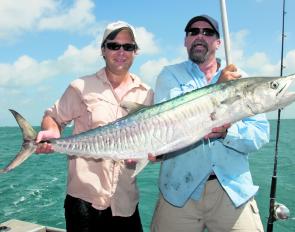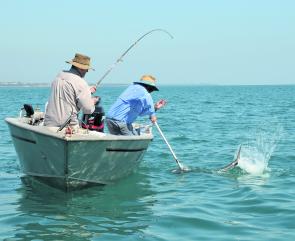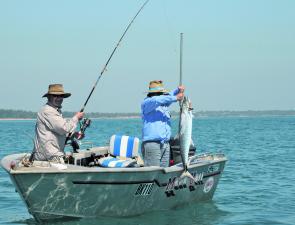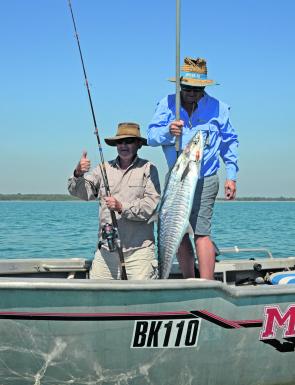The correct use of a gaff to land a big fish is something of a dying art (pardon the pun), especially in this age of increasing emphasis on catch-and-release. But there are still times when using a gaff is the best option available…
Over the previous couple of issues we’ve looked at a range of techniques for landing fish, including lifting, beaching, grabbing and netting them. The final option is gaffing, and this is often the very best way to go with particularly large and active adversaries. However, it needs to be stressed that gaffs shouldn’t be used on fish intended for catch-and-release. Even a reasonably carefully placed jaw or lip gaff can do serious damage to a fish, and greatly reduces its chances of survival. For this reason, keep the gaff strictly for those fish you intend to take home and eat.
A gaff is basically just a big, strong hook attached to a pole (in the case of a fixed gaff) or a rope (on a flying gaff or cliff gaff). Usually, this hook is barbless, but some flying and cliff gaffs do have barbs.
Gaffs are traditionally used to secure larger, more active fish, especially heavyweight targets such as tuna, mulloway, Spanish mackerel, kingfish, sharks and marlin, although they can also be useful on very large snapper, emperor and so on.
Gaffing is a little trickier than netting and requires a bit more practice to master. Unfortunately, most anglers don’t have the opportunity to catch large fish very often, so practice can be hard to come by. Therefore, being really clear on the steps you need to take to successfully gaff a fish before the moment of truth arrives is very important.
Let me stress once again: before even thinking about using a gaff, consider whether you want to keep or release the fish, because gaffing usually kills or badly injures the fish. Also, gaffs are not permitted by law in some areas or specific fisheries (particularly in some freshwater environments), so always check the rules first.
As with netting fish, the greatest chance of success occurs when the gaff operator keeps a cool head and acts smoothly but decisively at exactly the right moment. The following steps show how a gaff can be used in most situations:
1. Just before the fish breaks the surface, place the gaff handle over the fish’s back, behind its head, with the hook facing down.
2. Pull back and up smoothly on the gaff handle, using the weight and resistance of the fish itself to bury the hook into its flesh. (Heavier fish are generally easier to gaff than lighter ones.)
3. Smoothly continue the hook-setting stroke to lift the fish from the water and into the boat or up onto the rocks or pier.
This all sounds easy, but in practice, getting gaffing right is often easier said than done, especially in agile fish or those with heavy scale coverings that can tend to deflect the hook point.
As when dealing with every other aspect of hooking, playing and landing a fish, you need to try your best to think coolly and act smoothly when wielding a gaff. Although staying calm isn’t always easy with copious amounts of adrenalin pumping through your body, keeping a lid on your emotions more often brings rewards. The time to go wild and start jumping up and down with unbridled excitement is after you landed that fish-of-a-lifetime or a record-breaking catch!
Reads: 3593
Using a gaff is the safest, most secure course of action when a big, powerful fish like this Spanish mackerel is intended to be kept for the table.

The moment of truth as the gaff strikes home! Note that the gaff man has gone over the fish’s back with the gaff, just behind its head.

With the fish secured, keep it coming smoothly up and over the gunwale, using its own weight to help keep it on the gaff… watch those teeth, though!

A happy thumbs-up signals the perfect outcome: fish secured and safely in the boat, with minimal damage to that delicious flesh.




